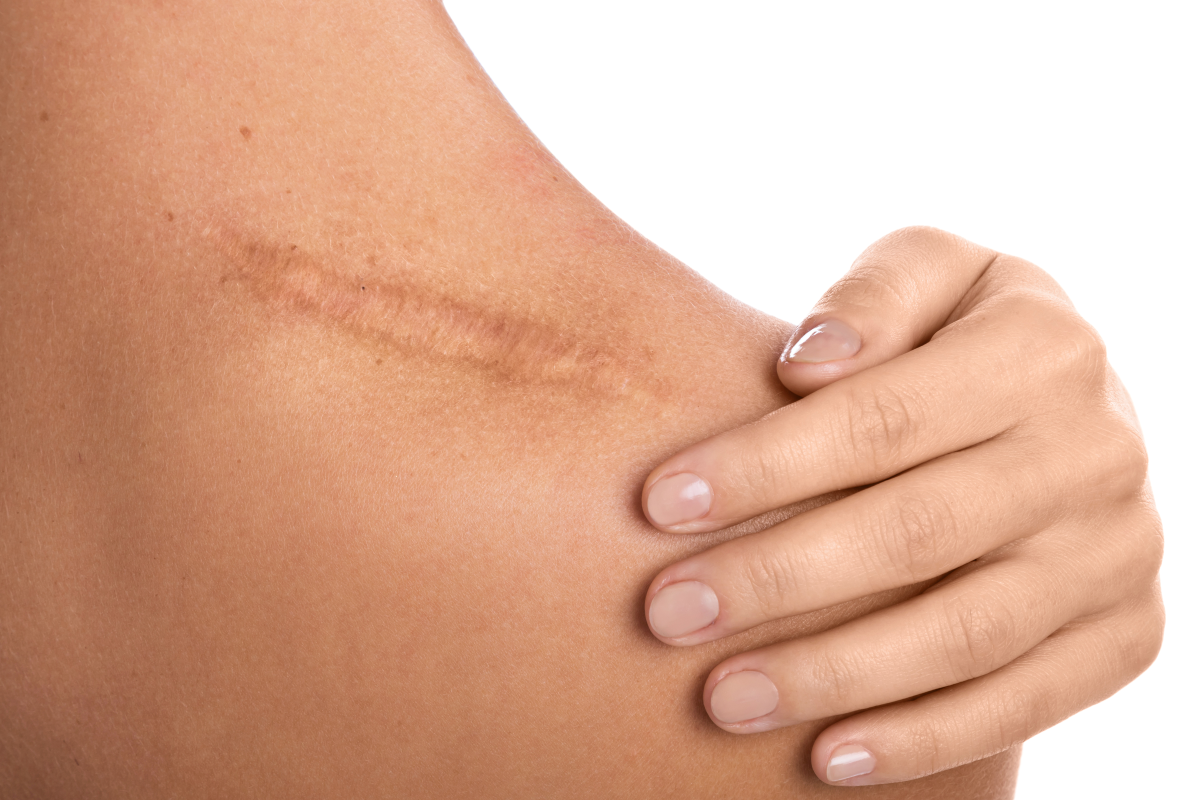Scars, whether caused by acne, surgery, burns, or injuries, impact skin’s appearance but also your confidence. Many people seek treatments to help fade, flatten, or minimize these marks. While no scar treatment is universal, an experienced dermatologist can offer numerous options for scar removal and remediation. In this blog, Dr. Jacqueline Watchmaker, MD, FAAD of U.S. Dermatology Partners in Scottsdale explores effective scar treatments and how to fade scars, including her most effective strategies for improving the appearance of specific types of scars.
Types of Scars & Why They Form
Before diving into specific scar treatments, it’s essential to understand the different types of scars and why they form. Each type of scar requires a unique approach to treatment, so determining the type of scar is the first step to improving the appearance and texture of scars.
Acne Scars
Acne scars are a common concern, particularly for those who have experienced cystic acne or severe breakouts. Acne scars range from mild discoloration to deep, pitted marks to rolling or box-car shaped scars. They can be on the face or body. These scars are the result of inflammation in the skin, which disrupts the collagen production process and leads to indentations or uneven skin tone and texture.
- Symptoms – can consist of discoloration, deep pitted scars, rolling scars, box-car scars, hypertrophic (raised) scars, atrophic (depressed) scars.
- Common treatments – laser therapy, microneedling, fillers, and chemical peels.
Hypertrophic & Keloid Scars
Hypertrophic scars are raised scars that form when the body produces too much collagen during the healing process. Keloids are more severe than hypertrophic scars because they have scar tissue that extends beyond the original wound. These thick, raised scars can be particularly noticeable when located on prominent areas of the body, such as the chest, shoulders, or earlobes. They can also itch and become irritated when rubbed on clothing or jewelry.
- Symptoms – thick, raised scars due to excess collagen production.
- Common treatments – steroid injections, fluorouracil (5FU) injections, laser treatments, and silicone scar gel/sheets.
Atrophic Scars
These are depressed scars are typically the result of conditions like acne, chickenpox, or other skin conditions that lead to tissue damage. They appear as shallow or deep pits.
- Symptoms – indented scars from acne, chickenpox, or other skin conditions or damage due to collagen loss.
- Common treatments – subcision, fillers, and laser resurfacing.
Surgical & Traumatic Scars
Surgical scars are the result of medical procedures, while traumatic scars result from injuries or burns. These scars may be discolored, raised, or bound down, depending on the injury’s severity and how the skin heals. They may also vary in texture and shape based on factors like healing time and the presence of infection.
- Symptoms – scars from surgeries, injuries, or burns that may be discolored or bound down.
- Common treatments – laser, subcision, and steroid injections.
Best Scar Improvement Treatments (Dermatologist-Recommended)
While there are various methods available for scar removal, many dermatologists, including Dr. Watchmaker, emphasize the importance of customizing the treatment based on the type and severity of the scar. Often, a combination of treatments works best to achieve the most significant improvement. Below are some of the most effective scar improvement treatments and recommendations from Dr. Watchmaker.
Laser Treatments (Best for Discoloration and Texture)
Laser treatments are among the most popular and effective options for improving the appearance of all types of scars. Dr. Watchmaker recommends laser treatments for reducing redness, uneven skin tone, and irregular texture caused by scar tissue formation. Various laser treatments can improve the appearance of all types of scars by improving the color and texture of the scar. Dr. Watchmaker explains, “For pink scars, a series of vascular laser treatments (like the pulsed dye laser) can be helpful. For rolling acne scars on the face, my favorite treatment is nonablative fractional lasers like the Fraxel 1550. For more severe acne scarring, I sometimes use an ablative laser like the CO2 or erbium laser”.
- Vascular Laser (for pink or red scars) – a vascular laser is effective for treating pink or red scars by targeting blood vessels in the scar tissue. The laser fades redness and promotes even skin tone. Dr. Watchmaker recommends this treatment for scars that are still healing or scars that have fully healed but still remain pink or red in appearance. Typically, a series of treatment are needed.
- Fraxel 1550 laser – for moderate acne scarring the Fraxel 1550 can help. This laser stimulates collagen production, helping to smooth skin texture and improve the overall appearance of the scars. Dr. Watchmaker suggests Fraxel 1550 for moderate acne scarring on the face. A series of treatments are needed.
- CO2 and erbium lasers: these are more aggressive lasers that can help resurface the skin. These are used for more significant scarring.
Microneedling & Radiofrequency Microneedling (Best for Mild to Moderate Acne Scars)
Microneedling is a popular treatment for stimulating collagen production and improving skin texture. This procedure involves using a device with fine needles to create micro-injuries to the skin, which promotes the healing process and encourages collagen production. Microneedling improves the appearance of mild acne scars, fine lines, and uneven skin texture. Dr. Watchmaker recommends microneedling for mild scarring, stating, “For mild scarring, I like microneedling because it can be effective with minimal downtime.”
For a more advanced treatment, radiofrequency (RF) microneedling can be used. This technique combines microneedling with radiofrequency energy to create deeper skin remodeling, making it more effective for deeper scars. It’s particularly helpful for mild to moderate acne scars.
Subcision & Fillers (Best for Atrophic Scars & Depressed Scars)
Atrophic scars, such as those caused by severe acne or chickenpox, often appear as depressed areas on the skin. These scars can be improved with subcision, a procedure that involves using a needle to break up the fibrous tissue underneath the scar. This helps release the tension that pulls down on the surface of the skin. Injectable dermal fillers, such as hyaluronic acid or biostimulatory fillers, can be used on their own or conjunction with subcision to restore volume and smooth the surface of pitted or sunken scars. Dr. Watchmaker highlights, “For bound-down scars, subcision combined with fillers works really well to lift and smooth the skin.”
Chemical Peels (Best for Skin Tone)
Chemical peels are an effective solution for improving skin tone. These peels work by applying a chemical solution to skin that removes the outermost layer, revealing smoother, healthier skin underneath. Chemical peels are particularly beneficial for fading post-acne hyperpigmentation.. Chemical peels are often used as part of a comprehensive treatment plan.
Popular chemical peel options include:
- Glycolic Acid Peels
- TCA Peels
- Jessner’s Peel
Steroid & 5FU Injections (Best for Hypertrophic & Keloid Scars)
Steroid injections are commonly used to treat hypertrophic and keloid scars. These injections reduce inflammation and break down excess collagen production that can lead to the formation of raised scars. 5-fluorouracil (5FU) is another medication that can be used in combination with steroid injections to further reduce the thickness of scars and improve skin’s appearance. Dr. Watchmaker shares her approach, “For raised scars, I use a combination of Kenalog, a steroid injection, and 5FU injections.”
Silicone Gels & Sheets (Best at home scar treatment)
For those who are looking to improve their scars at home, silicone gels and sheets can be helpful. These products create a moist environment that promotes healing. They are particularly helpful for new surgical or traumatic scars but can be used on any scars (no matter how old the scar is).
What’s the Best Scar Treatment for You?
The best scar treatment depends on many factors, including the type of scar, its age, its location, and your skin’s unique characteristics. Dr. Watchmaker emphasizes that dermatologists often recommend a combination and a series of treatments for the best results. For example, a vascular laser treatment may be combined with microneedling, or steroid injections may be used alongside laser therapy, depending on the severity and type of the scar. It’s always important to consult with a dermatologist who can assess your specific needs, recommend the best scar treatments, and develop a personalized care plan.
When to See a Dermatologist for Scar Improvement
If your scar causes discomfort, is dark, thick, or raised, or if home remedies aren’t working, it may be time to consult a dermatologist. Dermatologists can help determine the best treatment for your scar, whether it’s acne scars, surgical scars, or scars from traumatic injuries.
Reduce the Appearance of Scars & Feel Your Best
Scars don’t have to be permanent. Thanks to advancements in dermatology, there are many ways to improve the texture and appearance of scars. Whether through laser treatments, microneedling, chemical peels, or other innovative therapies, you can achieve smoother, more even skin and feel more confident.
Schedule a Dermatology Consultation
If you’re ready to explore your scar removal options, schedule a consultation with a board-certified dermatologist at U.S. Dermatology Partners to discuss which treatment plan is right for you. Once our local dermatology team receives your scheduling request, we’ll be in touch to finalize the details of your upcoming visit.
Find a location near me
or


